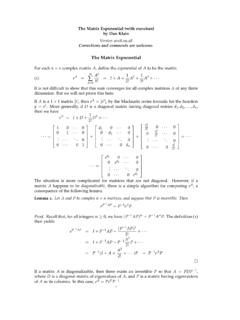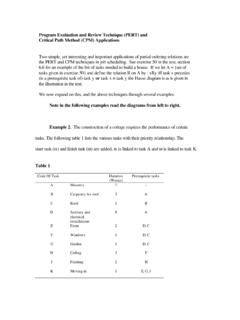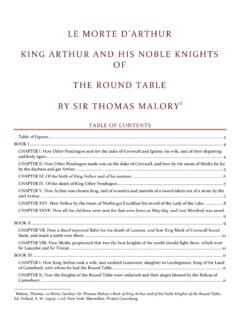Transcription of Grisly Assyrian Record of Torture and Death - faculty.uml.edu
1 Editor, H. S. (2002;2002). BAR 17:01 (Jan/Feb 1991). Biblical Archaeology Society. Grisly Assyrian Record of Torture and Death By Erika Belibtreu Scroll down to sidebar: The Black Obelisk Assyrian national history, as it has been preserved for us in inscriptions and pictures, consists almost solely of military campaigns and battles. It is as gory and bloodcurdling a history as we know. Assyria emerged as a territorial state in the 14th century Its territory covered approximately the northern part of modern Iraq. The first capital of Assyria was Assur, located about 150 miles north of modern Baghdad on the west bank of the Tigris River. The city was named for its national god, Assur, from which the name Assyria is also derived. From the outset, Assyria projected itself as a strong military power bent on conquest.
2 Countries and peoples that opposed Assyrian rule were punished by the destruction of their cities and the devastation of their fields and orchards. By the ninth century , Assyria had consolidated its hegemony over northern Mesopotamia. It was then that Assyrian armies marched beyond their own borders to expand their empire, seeking booty to finance their plans for still more conquest and power. By the mid-ninth century , the Assyrian menace posed a direct threat to the small Syro-Palestine states to the west, including Israel and Judah. The period from the ninth century to the end of the seventh century is known as the Neo- Assyrian period, during which the empire reached its zenith. The Babylonian destruction of their capital city Nineveh in 612 marks the end of the Neo- Assyrian empire, although a last Assyrian king , Ashur-uballit II, attempted to rescue the rest of the Assyrian state, by then only a small territory around Harran.
3 However, the Babylonian king Nabopolassar (625 605 ) invaded Harran in 610 and conquered it. In the following year, a final attempt was made by Ashur-uballit II to regain Harran with the help of troops from Egypt, but he did not succeed. Thereafter, Assyria disappears from history. We will focus here principally on the records of seven Neo- Assyrian kings, most of whom ruled successively. Because the kings left behind pictorial, as well as written, records, our knowledge of their military activities is unusually well documented: 1. Ashurnasirpal II 883 859 2. Shalmaneser III 858 824 3. Tiglath-pileser III 744 727 4. Sargon II 721 705 5. Sennacherib 704 681 6. Esarhaddon 680 669 7. Ashurbanipal 668 627 Incidentally, Assyrian records, as well as the Bible, mention the military contacts between the Neo- Assyrian empire and the small states of Israel and Judah.
4 An inscription of Shalmaneser III records a clash between his army and a coalition of enemies that included Ahab, king of Israel (c. 859 853 ). Indeed, Ahab, according to Shalmaneser, mustered more chariots (2,000) than any of the other allies arrayed against the Assyrian ruler at the battle of Qarqar on the Orontes (853 ). For a time, at least, the Assyrian advance was checked. An inscription on a stela from Tell al Rimah in northern Iraq, erected in 806 by Assyrian king Adad-nirari III, informs us that Jehoahaz, king of Israel (814 798 ), paid tribute to the Assyrian king : He [Adad-nirari Erich LessingAncient looters, the Assyrian soldiers carry away their booty after conquering Lachish in 701 , depicted in this detail from a relief in Sennacherib s Southwest Palace at Nineveh. The riches thus acquired provided important funding for the monumental construction programs that the Assyrian kings undertook.]
5 III of Assyria] received the tribute of Ia asu the Samarian Uehoahaz, king of Israel], of the Tyrian (ruler) and the Sidonian (ruler). From the inscriptions of Tiglath-pileser III and from some representations on the reliefs that decorated the walls of his palace at Nimrud, we learn that he too conducted a military campaign to the west and invaded Israel. Tiglath-pileser III received tribute from Menahem of Samaria (744 738 ), as the Bible tells us; the Assyrian king is there called Pulu ( 2 Kings 15:19 20 ). In another episode recorded in the Bible, Pekah, king of Israel (737 732 ), joined forces with Rezin of Damascus against king Ahaz of Judah ( 2 Kings 16:5 10 ). The Assyrian king Tiglath-pileser III successfully intervened against Pekah, who was then deposed. The Assyrian king then placed Hoshea on the Israelite throne.
6 By then Israel s northern provinces were devastated and part of her population was deported to Assyria ( 2 Kings 15:29 ). At one point, Israel, already but a shadow of its former self and crushed by the burden of the annual tribute to Assyria, decided to revolt. Shalmaneser V (726 722 ), who reigned after Tiglath-pileser III, marched into Israel, besieged its capital at Samaria and, after three years of fighting, destroyed it ( 2 Kings 18:10 ). This probably occurred in the last year of Shalmaneser V s reign (722 ). However, his successor, Sargon II, later claimed credit for the victory. In any event, this defeat ended the national identity of the northern kingdom of Israel. Sargon II deported, according to his own records, 27,290 Israelites, settling them, according to the Bible, near Harran on the Habur River and in the mountains of eastern Assyria ( 2 Kings 17:6 , 18:11 ).
7 Later, in 701 , when king Hezekiah of Judah withheld Assyrian tribute, Sargon II s successor, Sennacherib, marched into Judah, destroying, according to his claim, 46 cities and besieging Jerusalem. Although Sennacherib failed to capture Jerusalem ( 2 Kings 19:32 36 ), Hezekiah no doubt continued to pay tribute to Assyria. The two principal tasks of an Assyrian king were to engage in military exploits and to erect public buildings. Both of these tasks were regarded as religious duties. They were, in effect, acts of obedience toward the principal gods of Assyria. The historical records of ancient Assyria consist of tablets, prisms and cylinders of clay and alabaster. They bear inscriptions in cuneiform wedge-shaped impressions representing, for the most part, syllables. In addition, we have inscribed obelisks and stelae as well as inscriptions on stone slabs that lined the walls and covered the floors of Assyrian palaces and temples.
8 In all of these inscriptions, the king stands at the top of the hierarchy the most powerful person; he himself represents the state. All public acts are recorded as his achievements. All acts worthy of being recorded are attributed only to the Assyrian king , the focus of the ancient world. Stephanie Page, A Stela of Adad-nirari III and Nergal-eres from Tell al Rimah, Iraq 30 (1968), p. 143. Erich Lessing Impaled on stakes. Two Assyrian soldiers erect a stake with an impaled, naked man beside two others. The heads of these captured men of Lachish sag forward, suggesting that they are already dead. This detail comes from a series of reliefs, found at Nineveh, in which Sennacherib (704 681 ) recorded the exploits of his invasion of Judah in 701 Lachish was among the 46 cities he conquered.
9 The annals of the kings describe not only their military exploits, but also their building activities. This suggests that the spoil and booty taken during the military campaigns formed the financial foundation for the building activities of palaces, temples, canals and other public structures. The booty property and people probably provided not only precious building materials, but also artists and workmen deported from conquered territories. The inscriptional records are vividly supplemented by pictorial representations. These include reliefs on bronze bands that decorated important gates, reliefs carved on obelisks and some engravings on cylinder seals. But the largest and most informative group of monuments are the reliefs sculpted into the stone slabs that lined the palaces walls in the empire s capital cities-Nimrud (ancient Kalah), Khorsahad (ancient Dur Sharrukin) and Kuyunjik (ancient Nineveh).
10 According to the narrative representations on these reliefs, the Assyrians never lost a battle. Indeed, no Assyrian soldier is ever shown wounded or killed. The benevolence of the gods is always bestowed on the Assyrian king and his troops. Like the official written records, the scenes and figures are selected and arranged to Record the king s heroic deeds and to describe him as beloved of the gods : The king , who acts with the support of the great gods his lords and has conquered all lands, gained dominion over all highlands and received their tribute, captures of hostages, he who is victorious over all countries. The inscriptions and the pictorial evidence both provide detailed information regarding the Assyrian treatment of conquered peoples, their armies and their rulers. In his official royal inscriptions, Ashurnasirpal II calls himself the trampler of all enemies.
















